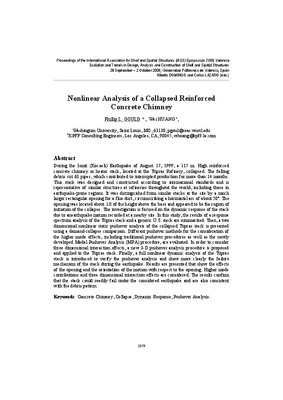JavaScript is disabled for your browser. Some features of this site may not work without it.
Buscar en RiuNet
Listar
Mi cuenta
Estadísticas
Ayuda RiuNet
Admin. UPV
Nonlinear analysis of a collapsed reinforced concrete chimney
Mostrar el registro sencillo del ítem
Ficheros en el ítem
| dc.contributor.author | GOULD, Phillip L.
|
|
| dc.contributor.author | HUANG, Wei
|
|
| dc.contributor.editor | Domingo Cabo, Alberto
|
es_ES |
| dc.contributor.editor | Lázaro Fernández, Carlos Manuel
|
es_ES |
| dc.date.accessioned | 2009-12-15T12:58:55Z | |
| dc.date.available | 2009-12-15T12:58:55Z | |
| dc.date.issued | 2009-12-15T12:58:55Z | |
| dc.identifier.isbn | 978-84-8363-461-5 | |
| dc.identifier.uri | http://hdl.handle.net/10251/6647 | |
| dc.description | p. 2879-2886 | en_EN |
| dc.description.abstract | During the Ismit (Kocaeli) Earthquake of August 17, 1999, a 115 m. High reinforced concrete chimney or heater stack, located at the Tüpras Refinery, collapsed. The falling debris cut 63 pipes, which contributed to interrupted production for more than 14 months. This stack was designed and constructed according to international standards and is representative of similar structures at refineries throughout the world, including those in earthquake-prone regions. It was distinguished from similar stacks at the site by a much larger rectangular opening for a flue duct, circumscribing a horizontal arc of about 50º. The opening was located about 1/3 of the height above the base and appeared to be the region of initiation of the collapse. The investigation is focused on the dynamic response of the stack due to anearthquake motion recorded at a nearby site. In this study, the results of a response spectrum analysis of the Tüpras stack and a generic U.S. stack are summarized. Then, a two dimensional nonlinear static pushover analysis of the collapsed Tüpras stack is presented using a demand-collapse comparison. Different pushover methods for the consideration of the higher mode effects, including traditional pushover procedures as well as the newly developed Modal Pushover Analysis (MPA) procedure, are evaluated. In order to consider three dimensional interaction effects, a new 3-D pushover analysis procedure is proposed and applied to the Tüpras stack. Finally, a full nonlinear dynamic analysis of the Tüpras stack is introduced to verify the pushover analysis and show more clearly the failure mechanism of the stack during the earthquake. Results are presented that show the effects of the opening and the orientation of the motion with respect to the opening. Higher mode contributions and three dimensional interaction effects are considered. The results confirm that the stack could readily fail under the considered earthquake and are also consistent with the debris pattern. | en_EN |
| dc.language | Inglés | en_EN |
| dc.publisher | Editorial Universitat Politècnica de València | es_ES |
| dc.relation.ispartof | Symposium of the International Association for Shell and Spatial Structures (50th. 2009. Valencia). Evolution and Trends in Design, Analysis and Construction of Shell and Spatial Structures : Proceedings | en_EN |
| dc.rights | Reserva de todos los derechos | en_EN |
| dc.subject | Concrete chimney | en_EN |
| dc.subject | Collapse | en_EN |
| dc.subject | Dynamic response | en_EN |
| dc.subject | Pushover analysis | en_EN |
| dc.title | Nonlinear analysis of a collapsed reinforced concrete chimney | en_EN |
| dc.type | Comunicación en congreso | en_EN |
| dc.rights.accessRights | Abierto | es_ES |
| dc.description.bibliographicCitation | Gould, PL.; Huang, W. (2009). Nonlinear analysis of a collapsed reinforced concrete chimney. Editorial Universitat Politècnica de València. http://hdl.handle.net/10251/6647 | es_ES |
| dc.relation.conferencename | Symposium of the International Association for Shell and Spatial Structures | es_ES |
| dc.relation.conferencedate | 2009 | es_ES |
| dc.relation.conferenceplace | Valencia | es_ES |






